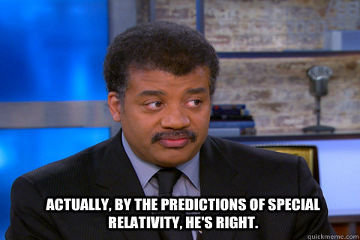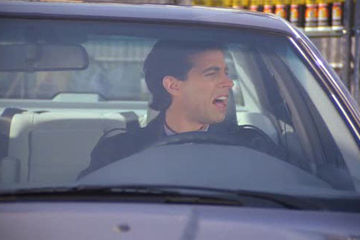What I’ve Learned:
“Gravitational lensing: mirror, mirror in the sky; show me what’s behind this guy.”
If you’ve ever sat behind a really tall person at a movie, then you know the infuriating problem of not being able to see something on the other side of a solid object. At the theater, you probably deal with this in the usual ways — hoping the heighty person slouches in their seat, or spontaneously loses six inches of height, or their head explodes like in that Scanners movie.
But astronomy tells us there’s another viable option, known as gravitational lensing. All you have to do is push the movie a few million light years away, and make that big fat head in front of you as dense as a ten-billion star galaxy.
It’s a little complicated. I’ll explain.
One of the (now-famous) predictions of Albert Einstein’s general theory of relativity is that space (really spacetime, but who’s counting?) is curved, and that hugely massive objects with lots of gravitational force will further warp that curving. So if a celestial light source — like, say, a quasar — lies behind an enormous gravitational well such as a galaxy, the light from the quasar would get curved around the galaxy and slingshot out the other side.
It might appear that the light source lies beside the big heavy thing in the way, because the light doesn’t bend all the way back to the middle. And if the source is directly behind the obstacle, the light could take more multiple paths around it — left, right, up, down, south by southwest — and appear more than once on our side. It could even form a full ring of light all around the object in the middle, weirdly indicating that the thing producing the light isn’t anywhere around the obstacle at all, but directly behind it.
I know, right? It’s spooky. Real call is coming from inside the house stuff.
Because Einstein described relativity, and was a generally awesome dude, the light rings caused by gravitational lensing are called “Einstein rings”. There are very few complete rings — caused by a massive energy source directly behind a star or galaxy — but hundreds of partial rings, multiple-image systems and other gravitational lensing events have been observed. One of the most impressive, called Einstein’s Cross — because, again, cool smart guy — consists of four “bent” images of a way-distant quasar curved around a still-way-distant-but-not-as-way-distant galaxy in between.
It’s like having a head in the way, but still seeing the movie in double-stereo-vision. Because astronomy makes everything better.
So what do you need to make gravitational lensing work? First, a source of some kind of energy. Many of the known ones work in visible light, but any kind of electromagnetic energy will do in a pinch. The universe isn’t picky.
The energy source has to be ridiculously strong, though, because you’ll need to see the signal from way far away. Not just from down the block, or from that window in your attic, either. Instead, from billions of light years away. Which is kind of a big deal.
Why so far? Because you then need to find an incredibly massive object to plop between you and the energy source to produce the gravitational lensing. A bowling ball isn’t going to do it. A star might, if it’s in precisely the right orientation. A whole galaxy of stars would be better. Or you could try Nicki Minaj’s ass. It’s big enough to attract most of the pop culture paparazzi into a close orbit, apparently. Maybe it could work; I don’t know.
The point is, you’ll only see gravitational lensing by throwing that hypermassive whatever between you and and the signal. And then you can watch that gravity well bend electromagnetic waves like Beckham, off a straight line and down to your eyes.
So maybe it won’t help you the next time you’re blocked at the movies. But gravitational lensing could show you a star behind another star some day. And really, isn’t that how the movie industry works in the first place?







